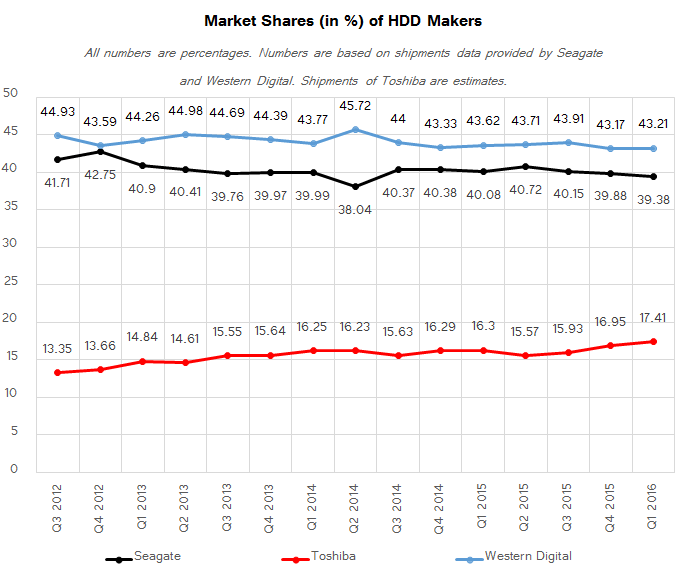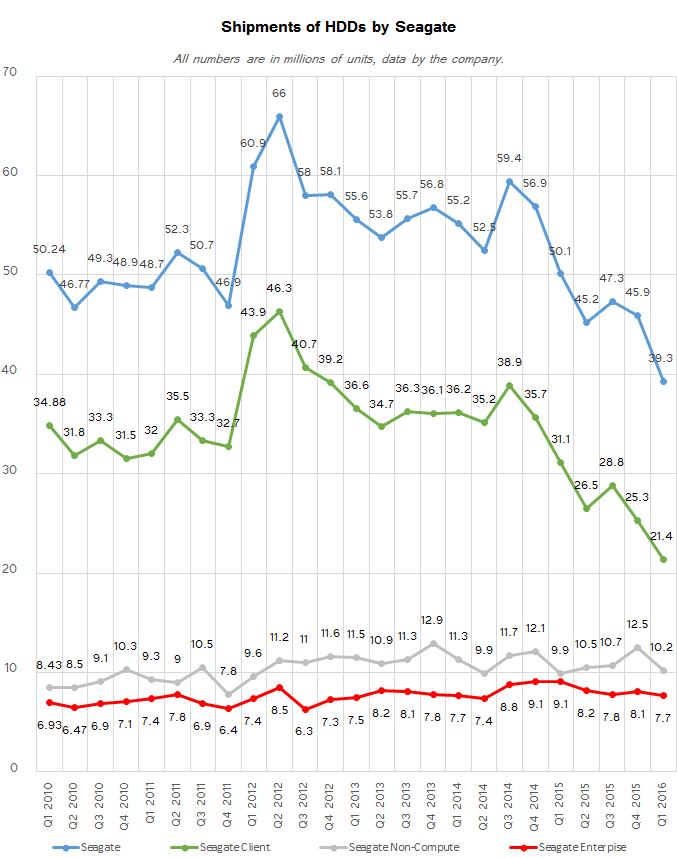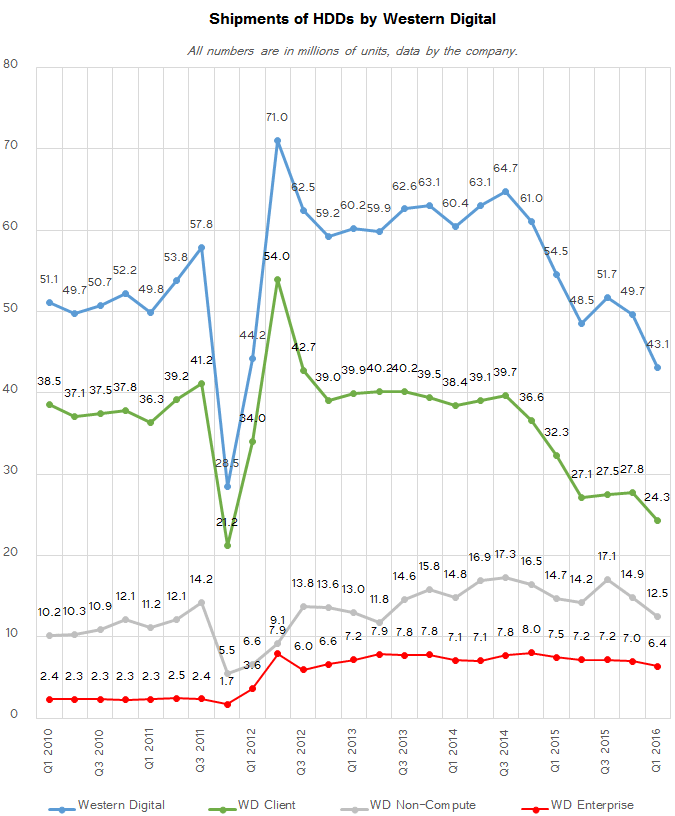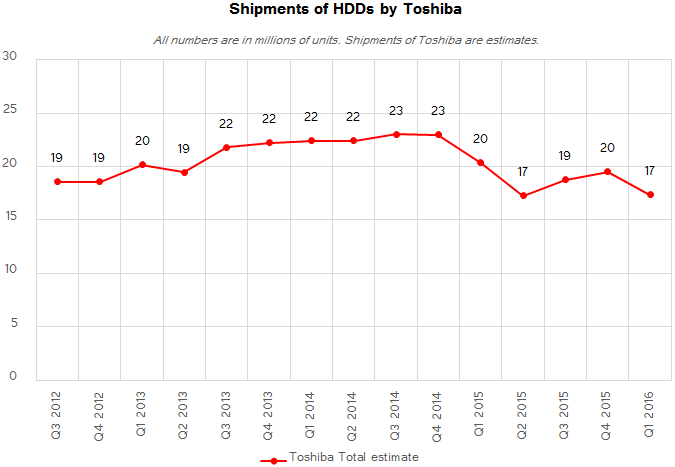Market Views: HDD Shipments Down 20% in Q1 2016, Hit Multi-Year Low
by Anton Shilov on May 12, 2016 8:00 AM ESTWestern Digital Remains World’s No. 1 HDD Supplier
Due to severe declines in demand for hard drives, it does not look like HDD makers want to fight for market share. Western Digital controlled about 43% of the HDD market in Q1 2016, just like a quarter before. Seagate was the second largest supplier with 39.38% market share. If the HDD shipments numbers for Toshiba are correct, then the company controlled around 17% of the hard drive market, moving ever so slightly higher.
Seagate’s HDD Sales Drop Below 40 Million Units, Company Plans Capacity Adjustments, Product Cuts
Seagate sold 39.3 million hard drives in the first quarter of 2016, a 21.5% decline from the same period a year ago. Sales of Seagate’s HDDs dropped across the board - with the exception of nearline drives. During the conference call with investors and financial analysts, the company particularly noted weak sales of client HDDs as well as declines in shipments of traditional mission-critical drives. Moreover, in a bid to maintain margins, the firm decided to “not aggressively participate in certain areas of the low capacity notebook market,” which further drove its unit sales down.
As it appears, Seagate does not seem to be confident that the hard drive market will rebound in the foreseeable future. The HDD maker intends to cut-down its manufacturing capacities from 55 – 60 million units per quarter to approximately 35 – 40 million units per quarter, which will help it to reduce operating costs and maintain prices despite competition from traditional and emerging rivals.
“In the March quarter we began the process of reducing our HDD manufacturing capacity from approximately 55 million to 60 million drives per quarter to approximately 35 million to 40 million drives per quarter,” said Steve Luczo, chief executive officer of Seagate, in a conference call with investors and financial analysts. “The actions required will be completed within the next 6 to 9 months. At the same time, we will continue to accelerate the utilization of our own drive factories internally and media facilities.”
While Seagate does not detail its capacity-cutting plans, it indicates that it intends to shift build volumes to its higher capacity models, which will simplify wafer requirements, optimize the lineup and will eventually reduce costs. In particular, the company will discontinue some of its low-capacity client HDDs (250 GB, 320 GB and 500 GB), which will help to increase its ASPs (average selling prices) and margins.
“In [Q1 2016] we began end-of-life activity on some of the older 500 GB and below products that have very low margins,” said Dave Mosley, president of operations and technology at Seagate. “Most of the margin cost benefits of these products will be realized over the next few quarters.”
In fact, Seagate began targeted pricing increases across its product portfolio already in the third quarter of its fiscal year (i.e., Q1 2016), which could help to improve its financial results. The manufacturer believes that higher HDD prices are justified because HDDs are getting harder to make. Since the company decided not to participate in some areas of the low capacity laptop market, it is evident that it may leave it to makers of entry-level SSDs in the future.
“In the March quarter we initiated targeted pricing increases across our product line, we were successful in some areas and unsuccessful in other,” said Mr. Luczo. “We continue to believe the industry needs a stable pricing environment to deliver the higher level of requirements being placed on our products and to realize the value we are providing to the market. As a result, we will continue to pursue a pricing strategy that reduces and properly reflects the investment in technology the market requires.”
Shipments of Western Digital’s HDDs Fall to 43.1 Million Units
Western Digital shipped 43.123 million of HDDs in the first three months of this year, or 21% less compared to Q1 2015. Sales of the company dropped across the board due to the weak PC market and seasonality. Just like Seagate, Western Digital increased prices of certain products during the quarter. In particular, the company hiked prices of some of its 2.5” drives for notebooks and gaming PCs (which is probably the WD Black2 Dual Drive). Right now, the company is making selective price increases in the enterprise segment in a bid to maintain its ASPs and margins and sustain its ability to invest in the development of products.
“Because we want to make sure that we have got sufficient dollars to reinvest back into our business to continue to innovate and provide compelling products for our customers, we are making selective price increases in certain enterprise markets,” said Stephen Milligan, chief executive officer of Western Digital, in a conference call with investors and financial analysts. “At this point, we are not sure if they're going to stick, but we are certainly hoping that they do.”
Earlier this year Western Digital announced plans to optimize its roadmap and close-down its head wafer manufacturing facility in Otawara, Japan, in a bid to reduce costs and maintain its profitability. So far, the company has not announced plans to reduce its HDD manufacturing capacities significantly but said it would eliminate redundant facilities. The company also did not make any comments regarding the future of its low-end HDDs.
Toshiba’s HDD Shipments Drop Too
Since Toshiba does not disclose anything related to its hard drive business, it is hard to analyze this supplier. If estimations of HDD makers and Nidec are correct, then Toshiba’s HDD shipments in Q1 2016 should be around 17 million units, or 15% below its shipments in the same period last year.














116 Comments
View All Comments
nils_ - Monday, May 30, 2016 - link
Is anyone still buying those 15k or even 10k drives?glad2meetu - Friday, May 13, 2016 - link
I think people are waiting to see what comes out of the merger between WD and Sandisk. I am surprised that Seagate did not make a bid late last year for Micron.I think much of the blame for the decline in the PC market in general is due to Intel failing to innovate. The drop in HDD shipments effectively just mirrors the lower number of new computers being shipped. But that may be a bit harsh on Intel and the rest of the PC industry. It has become much more difficult to make a game changing product given the level of excellence found in existing technology. The same can be said for smartphones.
Hard drives may turn around in another couple of years if designers can get hybrid drives to work as intended. Or perhaps 3D XPoint lives up to the hype and changes the market in another few years.
There also is a risk that the cost reduction on SSDs comes back to haunt them. General consumers will just lump all SSDs together or may view them based on brand names. So SSD makers could get hurt if the cheapest SSDs run into more issues for consumers.
avbohemen - Friday, May 13, 2016 - link
With these numbers, I am wondering: does this include disks delivered to the cloud providers (AWS, Azure, Google), Facebook and other big consumers? They are always expanding their datacenters and use a lot of storage, while no one seems to really know how big their "market share" is. Can anyone share some insight in this?Pix2Go - Friday, May 13, 2016 - link
The numbers in the article do include those customers. They typically are the ones using "Enterprise" drives, with some exceptions.As an idea of how many drives they need, consider this random nugget from "the internet":
"The volumes of storage Google needs are insane: as the post notes, YouTube alone requires a petabyte of new storage every single day."
Yep, at least 1000TB a day in new storage requirements. And I'd bet that's a low estimate.
This link doesn't give a solid answer, but gives some ideas about how much data is really out there. https://www.backblaze.com/blog/200-petabytes-of-cu...
revanchrist - Friday, May 13, 2016 - link
Couldn't agreed more with what some already said. The per GB price of HDD will not go further down, it will just stay stagnant. Right now the lowest per GB price is on 3TB and 4TB drives, once you go further up eyeing for 5TB and more, the prices simply rocket sky high. I think in the future, all those 1TB and 2TB drives will go extinct while 5TB and higher prices will drop down to the level of 3TB and 4TB. 1TB and lower storage space belongs to the SSD, and it will happen very soon.StrangerGuy - Friday, May 13, 2016 - link
My educated guess is that costs of HDDs doesn't scale well at the low end since HDD manufacturers still have to build the entire drive assembly minus platters for a 1TB or less HDD while NAND is far more flexible in physical packaging.zodiacfml - Friday, May 13, 2016 - link
LOL. I feel bad for these ageing kings of storage.They have to throw out their cash and apply for some loans to be build a NAND fab. It is the only way to stay relevant for the next 10 to 20 years. SSDs are already eating from the top and bottom of the food chain. The last remaining stronghold of HDDs is cost per GB; but SSDs doesn't have to go there as HDDs didn't replaced Tape drives for cost per GB.
zodiacfml - Friday, May 13, 2016 - link
Edit: Got carried away and forgot WDs acquisition of Sandisk which puts them on track. Seagate, just do it.vivekvs1992 - Saturday, May 14, 2016 - link
Most of the reasons for declining sales are because of steafy decline in the pricing of small to medium capacity ssd, hdd are used for long term storage nowadays and those drives are never below 1tb, personally i have 2 2tb usb hdd, 1 1tb usb hdd and a 2 tb in my build, and 2 more 2 tb beauties are on their way... The thing is many of my friends don't consider that they can add another hard disk without removing the old one in a desktop, another lot of them don't need so m7ch storage and the last lot are unaware of this data expansion methodFriendlyUser - Saturday, May 14, 2016 - link
For a lot of stuff we have gone from "owning" digital libraries to "subscribing". If people had to locally store their netflix content or their Amazon books and their MP3s, the need for space would have grown considerably. With a fast network you can always rely on re-downloading content you want, instead of storing.Also, in my opinion, the industry has stagnated. Price per GB is today similar to what I paid the last time I upgraded my HDs, in 2009. This is unacceptable. I know I would have bought a ton of 2.5" 2TB HDs for backups and the like, but they are still priced at ~$100. Too expensive... Plus, there has been little progress with hybrid HD/SSDs, which would be a great solution for people who don't want to mess with multiple drives. In fact, all I see is rebranding the same drive with slightly modified firmware and selling it as "NAS" or "workstation" or "IP camera" or "NAS pro" or "Storage" etc.
They have been milking us for too long. Time to start innovating.